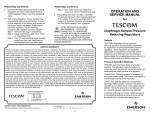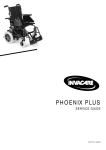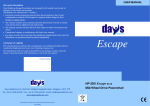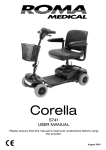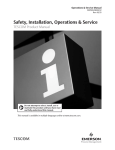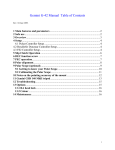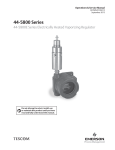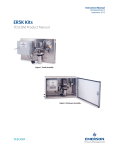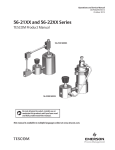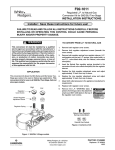Download operation and service manual - Welcome to Emerson Process
Transcript
Reassembly (continued)
6. Dome/Spring Combination and Dome
Loaded Regulators are more easily
reassembled by holding regulator firmly in
vise and reinstalling dome.
7. Self-Venting Regulator - If your regulator
has an adjustable vent valve mechanism,
it is set on final assembly at the factory
and usually will not require further
adjustment. If adjustment becomes
necessary, use the following procedure
after regulator has been installed:
Step 1. Remove hole plug located in
control knob.
Step 2. Using control knob, apply 10 to 15 psi on downstream side.
Step 3. Turn vent adjusting screw CW
(located under hole plug) until
media can be heard escaping
through vent valve.
Step 4. Turn screw CCW until media flow
stops, plus 1/2 turn. Replace hole plug.
8. Reinstalling wire mesh inlet filter - Insert
filter into primary inlet port. It must then
be expanded to fit correctly. This can be
accomplished by inserting a metal tool
the same size as the port and then lightly
tapping it with a hammer.
After regulator has been
reassembled, it should be
connecteD To a Pressure
source with media
compatible with the use of the
regulator and pressurized to
check for internal and external
leakage and operating
characteristics.
Monel® is a registered trademark of Huntington AlIoys, Inc.
Hastelloy® is a registered trademark of Haynes International, Inc.
Teflon®, Viton-A® and Vespel® are registered trademarks of DuPont.
DOPSM1886X012 Rev. 10/10 10M
6
LIMITED WARRANTY
Tescom Corporation (“Seller”) warrants that the licensed firmware embodied in the goods will execute the
programming instructions provided by Seller, and that the goods manufactured or services provided by Seller
will be free from defects in materials or workmanship under normal use and care until the expiration of the
applicable warranty period. Goods are warranted for twelve (12) months from the date of initial installation
or eighteen (18) months from the date of shipment by Seller, whichever period expires first. Consumables
and services are warranted for a period of 90 days from the date of shipment or completion of the services.
Products purchased by Seller from a third party for resale to Buyer ("Resale Products") shall carry only the
warranty extended by the original manufacturer. Buyer agrees that Seller has no liability for Resale Products
beyond making a reasonable commercial effort to arrange for procurement and shipping of the Resale
Products. If buyer discovers any warranty defects and notifies Seller thereof in writing during the applicable
warranty period, Seller shall, at its option, correct any errors that are found by Seller in the firmware of
services or repair or replace F.O.B. point of manufacture that portion of the goods or firmware found by Seller
to be defective, or refund the purchase price of the defective portion of the goods/services. All replacements
or repairs necessitated by inadequate maintenance, normal wear and usage, unsuitable power sources or
environmental conditions, accident, misuse, improper installation, modification, repair, storage or handling,
or any other cause not the fault of Seller are not covered by this limited warranty, and shall be at buyer's
expense. Seller shall not be obligated to pay any costs or charges incurred by buyer or any other party
except as may be agreed upon in writing in advance by Seller. All costs of dismantling, reinstallation and
freight and the time and expenses of Seller's personnel and representatives for site travel and diagnosis
under this warranty clause shall be borne by buyer unless accepted in writing by Seller. Goods repaired
and parts replaced by Seller during the warranty period shall be in warranty for the remainder of the original
warranty period or ninety (90) days, whichever is longer. This limited warranty is the only warranty made by
Seller and can be amended only in a writing signed by Seller. THE WARRANTIES AND REMEDIES SET
FORTH ABOVE ARE EXCLUSIVE. THERE ARE NO REPRESENTATIONS OR WARRANTIES OF ANY
KIND, EXPRESSED OR IMPLIED, AS TO MERCHANTABILITY, FITNESS FOR PARTICULAR PURPOSE
OR ANY OTHER MATTER WITH RESPECT TO ANY OF THE GOOD OR SERVICES.
12616 Industrial Boulevard
Elk River, MN 55330 USA
T +1 800 447 1250
+1 763 241 3238
F +1 763 241 3224
E [email protected]
W www.tescom.com
OPERATION AND
SERVICE MANUAL
for
Piston Sensed Pressure
Reducing Regulators
General
TESCOM™ piston sensed pressure reducing
regulators are specifically engineered for
applications requiring dependable pressure
regulation. These regulators are especially
appropriate for installations where high system
pressures (up to 20,000 psi) must be reduced
to levels suitable for actuating low pressure
(0 to 20,000 psi) instruments and related
equipment.
Pressure Activation Methods
TESCOM uses three basic types of activation
methods. The activation method provides
the means by which the operator can set the
force that determines the outlet pressure of a
regulator.
Control Knob: Delivery pressure is increased
by turning the control knob. The control knob
applies a load through a spring to the piston.
Dome Load: Delivery pressure is increased
by applying pressurized gas or liquid to the
dome of a regulator at a pressure equal to the
outlet pressure desired. This dome pressure
is normally provided by a second regulator
called the pilot regulator.
Combination Spring and Dome: Delivery
pressure is increased by applying a spring
force as well as the introduction of pressurized
gas or liquid.
©Tescom Corporation, 2010; All Rights Reserved.
Tescom™ is a business unit of Emerson Process Management Regulator Technologies, Inc.
Trademarks are property of divisions of Emerson Process Management.
Air Actuated (Multiplier): Delivery pressure
is controlled by applying 0-100 PSIG pilot
pressure to the air actuator, resulting in full
outlet pressure range control.
Materials of Construction
Standard materials of construction contacting
the fluid media can be any of the following:
Regulator Body: 300 Series SST, Brass,
Hastelloy®, Monel®, Aluminum
Seats: Teflon®, CTFE, Vespel®, Peek®, Soft
Goods (O-rings & back-up Rings) Teflon®,
BUNA-N, Viton A®
Trim: 300 Series SST, Brass, Hastelloy,
Monel, Aluminum
The official material of construction and
pressure activation method for your pressure
reducing regulator depends on series number
and modification ordered.
Operation (Control Knob Adjustment)
Controlled outlet pressure settings are
obtained using TESCOM pressure reducing
regulators by adjusting the control knob. Rotating the knob clockwise raises the outlet
pressure while a counterclockwise rotation,
coupled with venting of the downstream side
of the regulator plumbing, lowers the outlet
pressure. Final adjustments should be made
in the direction of increasing pressure to
obtain the most accurate set point.
TESCOM regulators will operate with any
liquid or gaseous media compatible with the
wetted materials. Some series/modifications
come with an internal filter that only are
designed to stop random contamination
resulting from the installation of the regulator. An auxiliary upstream filter is recommended
for use in all but the cleanest media. Gaseous
media should be free of excessive moisture
to prevent icing of the regulator at high flow
rates.
A regulator is not intended to
be used as a shutoff device.
When the regulator is not in
use, the inlet supply should
be turned off. As a safety
precaution, a pressure relief device
should be installed downstream of
the regulator.
2
Maintenance
The following procedures are provided to
enable the customer to perform all normal
maintenance and repair operations. These
operations are more easily performed with the
regulator removed from the line. However,
in some cases repair may be accomplished
without removal of the regulator body as long
as the supply has been shut off and the inlet
and outlet pressures have been vented.
The following steps outline the disassembly of
pressure reducing regulators for maintenance
and repair. Up-to-date assembly drawings
and bills of material are available from the
factory.
1. Clamp the regulator in a vise by the flats
on the bottom and/or side of the regulator
body.
2. Turn control knob and/or spring
adjustment mechanism counterclockwise
to insure removal of all spring force on the
piston.
NOTE: (Dome loaded regulators): All
pressurized gas or liquid must be vented
from dome before disassembly.
3. Remove upper portion of regulator (bonnet
and/or dome). Some models require the
handknob and/or mounting bracket to be
removed first.
NOTE: Upper portion of regulator may
also include spring button, load spring
back-up plate, and piston sensor, etc.
Review correct drawing to ensure that all
parts have been disassembled.
NOTE: (Two-Stage Regulator) TESCOM
Model Series BB-5 is a two-stage
regulator that has portions on both ends of
the regulator body that must be removed.
It is TESCOM’s recommendation that twostage regulators be returned to the factory
for repair.
3
Maintenance (continued)
4. The valve parts can now be removed from
the regulator body by turning the seat
retainer and/or back cap counterclockwise
until it is free of the regulator body.
TESCOM Models 26-1000 and
44-1100 valve parts are held
in place by the use of
left-handed threads.
NOTE: If necessary, valve seat may be
removed from the seat retainer using a
sharp instrument.
CAUTION: When removing valve parts
from a regulator that has a back cap, care
must be taken to insure the main valve
stem remains vertical. If the main valve
stem is not removed correctly, parts may
remain in the regulator.
5. To disassemble main valve assembly and/
or valve, clamp valve in smoothed jaw vice
or hold with pliers. Clamping should be
done on flats.
CAUTION: Care must be used to not
damage valve. A special fixture may
be ordered from the factory to aid in the
disassembly of the main valve assembly
found in TESCOM Regulator Models 26-1000 and 44-1100.
NOTE: Several TESCOM regulators
are supplied with internal filters. They
will be located either in the inlet port or
in the main valve area of the regulator. In
each case, they should be removed and
replaced before reassembly.
Reassembly
The regulator is reassembled in the reverse
order of disassembly, observing the following
precautions. Please reference the Bill of
Material and assembly drawing for the correct
location of replacement parts and correct
torque specifications. 4
Reassembly (continued)
1. Inspect all parts and replace those worn
or damaged with TESCOM replacement
parts.
2. All parts should be cleaned to the
cleanliness level required for safe
operation with the media and system they
will be used in. All parts in the flow stream
must be free of particles which could
prevent proper seating of the main valve.
3. Apply a thin uniform coating of
fluorocarbon grease to any or all of the
following parts: indentation of spring
button, threaded portion of adjusting
screw, entire threaded area of the bonnet,
all O-rings, all threaded parts internal to
regulator.
NOTE: Do NOT apply any type of grease
to the inlet or outlet connections.
4. Valve seats must be installed with the
chamfered side towards the main valve.
5. Standard Regulator with Control Knobs The body and bonnet are best joined
by holding the bonnet assembly open
end up and dropping all required items
into place one at a time. The last item
to be placed in the body of most all of
TESCOM regulators is the piston sensor. Place all O-rings and back-up rings that
are external to the piston sensor in the
body before placing the sensor in place. O-rings should always be installed before
back-up rings. The bonnet and body
may now be attached. This is best done
by holding the body in one hand and
the bonnet in the other. Tilt the body at
a 45° angle and then attach the bonnet
by screwing it into the body firmly, hand
tight. Regulator should then be placed
in vise and bonnet retorqued to correct
specifications. See print.
5


